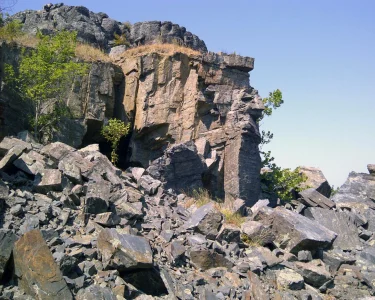CAPE CANAVERAL, Fla. — A spacecraft blasted off Monday to investigate the scene of a cosmic crash.
The European Space Agency’s Hera spacecraft rocketed away on a two-year journey to the small, harmless asteroid rammed by NASA two years ago in a dress rehearsal for the day a killer space rock threatens Earth. It’s the second part of a planetary defense test that could one day help save the planet.
SpaceX’s Falcon rocket quickly disappeared with Hera into the late morning clouds. An hour later, applause erupted in the control center in Germany as the spacecraft separated from the rocket’s upper stage and then called home. “It’s an amazing day,” the space agency’s director general Josef Aschbacher said afterward.
The 2022 crash by NASA’s Dart spacecraft shortened Dimorphos’ orbit around its bigger companion, demonstrating that if a dangerous rock was headed our way, there’s a chance it could be knocked off course with enough advance notice.
Scientists are eager to examine the impact’s aftermath up close to know exactly how effective Dart was and what changes might be needed to safeguard Earth in the future.
 SpaceX’s Falcon rocket quickly disappeared with Hera into the late morning clouds. An hour later, applause erupted in the control center in Germany as the spacecraft separated from the rocket’s upper stage and then called home. “It’s an amazing day,” the space agency’s director general Josef Aschbacher said afterward.
SpaceX’s Falcon rocket quickly disappeared with Hera into the late morning clouds. An hour later, applause erupted in the control center in Germany as the spacecraft separated from the rocket’s upper stage and then called home. “It’s an amazing day,” the space agency’s director general Josef Aschbacher said afterward.
“The more detail we can glean the better as it may be important for planning a future deflection mission should one be needed,” University of Maryland astronomer Derek Richardson said before launch.
Researchers want to know whether Dart — short for Double Asteroid Redirection Test — left a crater or perhaps reshaped the 500-foot (150-meter) asteroid more dramatically. It looked something like a flying saucer before Dart’s blow and may now resemble a kidney bean, said Richardson, who took part in the Dart mission and is helping with Hera.




 This image provided by NASA shows the asteroid Dimorphos, captured by NASA’s DART mission just two seconds before the spacecraft struck its surface, on Sept. 26, 2022.
This image provided by NASA shows the asteroid Dimorphos, captured by NASA’s DART mission just two seconds before the spacecraft struck its surface, on Sept. 26, 2022. This image provided by NASA shows the asteroid Dimorphos, captured by NASA’s DART mission just two seconds before the spacecraft struck its surface, on Sept. 26, 2022. (NASA/Johns Hopkins APL via AP)
This image provided by NASA shows the asteroid Dimorphos, captured by NASA’s DART mission just two seconds before the spacecraft struck its surface, on Sept. 26, 2022. (NASA/Johns Hopkins APL via AP)

